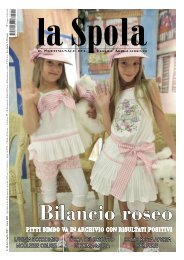fairs first summer without Prima interview itma, the day ... - La Spola
fairs first summer without Prima interview itma, the day ... - La Spola
fairs first summer without Prima interview itma, the day ... - La Spola
You also want an ePaper? Increase the reach of your titles
YUMPU automatically turns print PDFs into web optimized ePapers that Google loves.
40 production<br />
The stronghold that hopes<br />
<strong>La</strong> roccaforte che vuol rompere l’assedio<br />
to smash <strong>the</strong> siege<br />
di Matteo Grazzini<br />
It’s <strong>the</strong> <strong>first</strong> real link in <strong>the</strong> textile production chain and <strong>the</strong> <strong>first</strong> bastion that totters when economic crisis or competition strikes. Yet it’s also <strong>the</strong> <strong>first</strong><br />
point of reference for those with imagination, far-reaching vision and <strong>the</strong> capacity to understand and interpret <strong>the</strong> trends and needs of fashion. For<br />
several years now, <strong>the</strong> textile production chain has been hit hard by <strong>the</strong> economic crisis. Its repercussions include a loss of jobs, fierce competitors<br />
with headquarters that are extremely far from Italy and an incomparably skilled taskforce that’s forced to face a market that’s still more anchored to<br />
price than to quality. For all of <strong>the</strong>se reasons, experts within <strong>the</strong> textile-clothing sector scrutinize <strong>the</strong> wellbeing of <strong>the</strong> textile production chain with<br />
ever-increasing interest. The one hundred brands participating in Florence’s Pitti Filati and Expofil in Paris (a fair dedicated to niche research and<br />
quality) constitute an au<strong>the</strong>ntic stronghold—<strong>the</strong> hub of historic made-in-Italy products. And this is precisely <strong>the</strong> place that’s a point of reference for<br />
<strong>the</strong> market.<br />
‘Judging by orders, <strong>the</strong> sector’s barometer indicates stormy wea<strong>the</strong>r, partly because 2012 didn’t pick up <strong>the</strong> baton from <strong>the</strong> dynamic start seen at<br />
<strong>the</strong> beginning of 2011; instead, to<strong>day</strong> is more linked to last year’s final stages which ended with extreme effort. If we look at KG products, forecasts<br />
for <strong>the</strong> rest of <strong>the</strong> year are negative,’ explains Guido Pagliai, from Spicciano’s textile production industry, who’s president of <strong>the</strong> Prato Industrial<br />
Union’s Group for Textile chain production and weaving factories. ‘If 2011 went well until September, <strong>the</strong>n in 2012, we have already witnessed<br />
signs of a slow-down. If ready-made fashion doesn’t give us a hand, we’ll have to prepare ourselves for a difficult second semester. On <strong>the</strong> o<strong>the</strong>r<br />
hand, from <strong>the</strong> <strong>fairs</strong> we expect to reach a better understanding about whe<strong>the</strong>r our product is a trend in and of itself. It appears that way, but one of<br />
<strong>the</strong> salon’s objectives is to gain visiting clients.’<br />
When discussing expectations with regards to global markets, <strong>the</strong> conversation turns to cut-and-dried politics and economics. ‘The Union works<br />
Primo anello vero della filiera e primo baluardo a vacillare sotto i colpi della crisi e della concorrenza. Ma anche primo riferimento per chi<br />
ha fantasia, capacità di vedere lontano, di capire il mercato e di interpretare mode e necessità.<br />
Quello della filatura è, ormai da anni, uno dei settori più colpiti dalla crisi: posti di lavoro persi, concorrenti agguerriti con sedi ben lontane<br />
dall’Italia, capacità inarrivabili ma mercato ancorato più a logiche di prezzo che di qualità: per questo tutti gli addetti ai lavori del settore<br />
del tessile-abbigliamento guardano con occhi sempre più interessati allo stato di salute delle filature.<br />
I cento marchi presenti a Pitti Filati a Firenze e la nicchia di ricerca e qualità di Expofil a Parigi sono la roccaforte intorno alla quale si<br />
muove il made in Italy storico ed è proprio da qui che arriva un punto sul mercato.<br />
A giudicare dagli ordini il barometro indica burrasca, anche perchè il 2012 ha raccolto il testimone non dal 2011 iniziato in grande<br />
dinamicità ma da quello che ha chiuso con il fiatone.<br />
“Se guardiamo ai kg prodotti – spiega Guido Pagliai, della Filatura di Spicciano, presidente del Gruppo Filature e Tessiture<br />
dell’Unione Industriale Pratese – le previsioni per il resto dell’anno sono negative. Se il 2011 era andato bene fino a settembre nel 2012 già<br />
adesso abbiamo segnali di frenata e se non ci aiuta un po’ il pronto moda ci dobbiamo preparare aun secondo semestre difficile. Dalle fiere ci<br />
aspettiamo invece di capire se il nostro prodotto è in tendenza e pare che sia così, ma il salone serve anche per farsi visitare dai clienti”.<br />
E se la domanda invece tocca le aspettative a livello di mercati globali si passa alla politica e all’economia spicciola: “L’Unione – spiega<br />
Pagliai – lavora sul concetto di reciprocità ma ci sono tanti interessi in ballo e dipende da governi e politici. Di sicuro quando manca il<br />
lavoro manca un adeguato prezzo remunerativo e non riesco a capire come faccia qualcuno ad andare avanti con i prezzi bassi che sta




